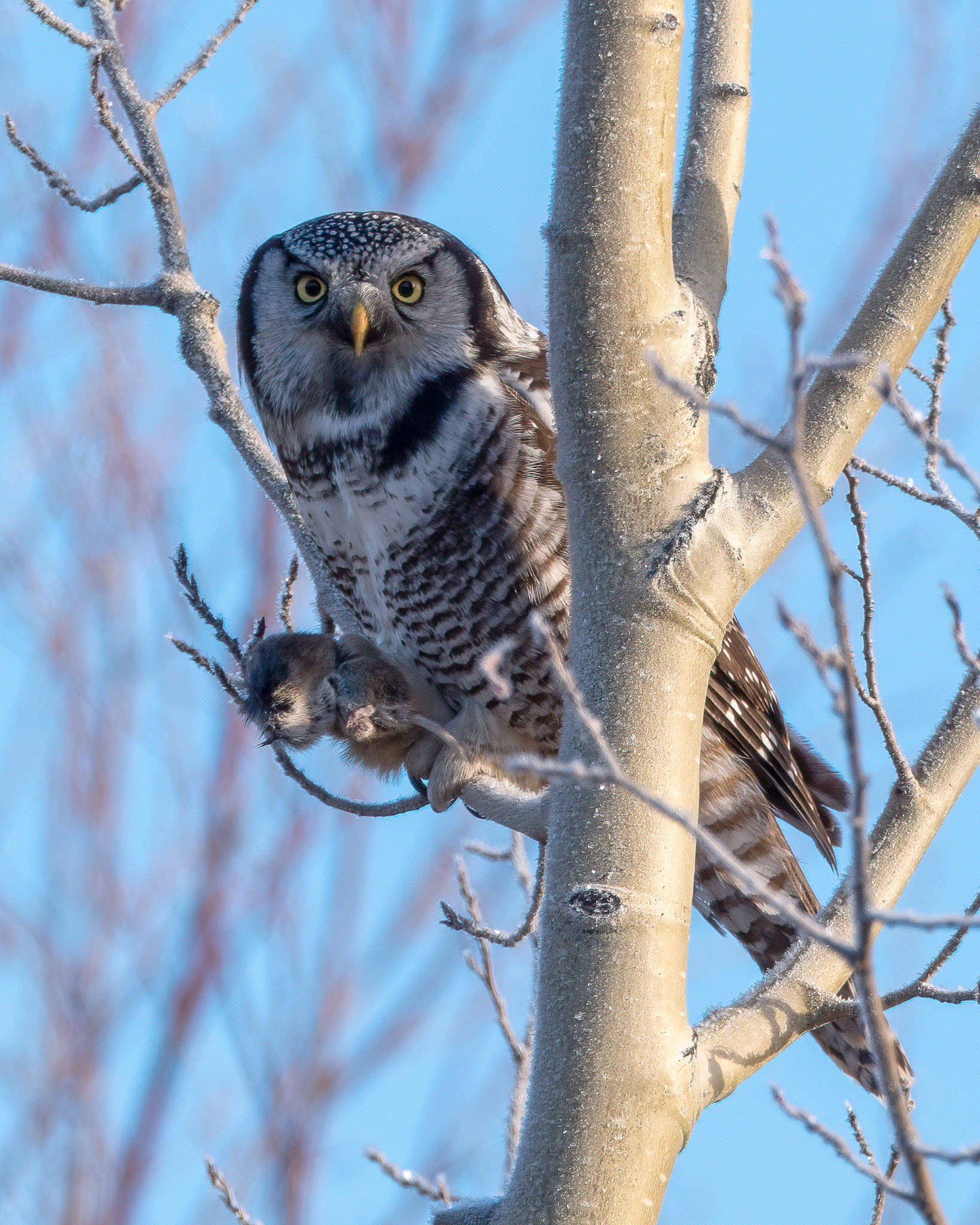In a gliding dive it swooped down from atop an aspen and disappeared, plunging into the fresh snow behind a stand of willows. I hunkered in beside a white spruce, hoping to catch a glimpse of the magnificent bird again.
The condensation from my breath had fogged up the viewfinder on my camera, which made it nearly impossible to peer through. As I cleared it off, up sprang the winged hunter, flying back into the tree from which it had launched. In its grasp was a red-backed vole.
At first glance, this bird of prey could easily have been mistaken for a hawk or falcon: dark, transverse stripes on light underparts, a slender build, pointed wings, long, tapered tail, and hawklike in flight and behavior. The head is where distinct features of an owl began to emerge, with a smoky grey, semi-disk shaped face, outlined by black bands and brilliant yellow eyes.
This undoubtedly is how it got its name, the Northern Hawk Owl.
Northern Hawk Owls (Surnia ulula) live around the world in boreal forests of the far north. There are three subspecies — two in Asia and one in North America.
Being nonmigratory, Northern Hawk Owls will remain within localized areas until prey becomes scarce, driving them to leave in search of locations with more productive hunting. With severe weather conditions or the cyclical abundance of voles, hares and other small-mammal populations, depending on geographical locations, hawk owls may “irrupt” south of their normal range.
The preferred habitat of hawk owls consists of moderately dense boreal forests, tundra, muskegs, burned areas and semi-open areas for hunting.
Northern Hawk Owls are considered partially diurnal, meaning they hunt by day, which is somewhat more characteristic of hawks than other species of owls. However, hawk owls are more active throughout the morning and evening hours and may hunt at night during the winter.
Most nocturnal species of owls such as Great Gray, Saw-whet and Boreal owls have asymmetrical (different on each side) ear openings, allowing them to have more accuracy and precision when locating prey at night. Northern Hawk Owls have symmetrical ear openings, which provides reason to believe that their hearing may not be as sharp as their nocturnal cousins and that they rely more on sight than sound to hunt.
Depending on the year and region, voles, lemmings and juvenile snowshoe hares make up a majority of the hawk owl’s diet, supplemented by shrews, mice, insects, red squirrels and birds. Hawk owls have also been observed preying on adult snowshoe hares, spruce grouse and ducks. Having a diverse diet ensures the survival of hawk owls in the harsh environments of their range.
In Alaska, the breeding season commonly coincides with prey availability, which can start as early as March. Once a male establishes a territory, it commences calling and flight displays in order to catch the attention of a female. The pair do not build a traditional nest but lay eggs within tree cavities or the tops of stumps.
From mid-April to May the pair will lay roughly 3 to 13 eggs per brood, which varies on prey abundance. While the female incubates the eggs, the male hunts and provides sustenance for the female.
Three weeks after hatching, the owlets fledge and leave the nest. They will remain relatively close to the nest area for an additional three or four weeks so the parents can continue to provide food and protection.
A majority of the information on Northern Hawk Owls originates from extensive studies conducted in Scandinavia. In North America, they are one of our least studied birds, with the most substantial research coming out of Denali National Park and more recently the Yukon Territory, Canada. With this research, we have a much greater understanding about the ecology of these owls, but there is still a lot to learn.
So far, this year has been an exceptional year for viewing Northern Hawk Owls on the refuge. I have logged nine sightings since mid-September, with the most recent being Nov. 30. These were all seen near the edges of clearings perched on top of spruce and aspen trees or on boughs of dead timber in the burn area of the Swan Lake Fire.
While out playing and enjoying the refuge this winter, take a look around every once in a while and maybe you’ll set your eyes on this hardy owl of the north.
Colin Canterbury is a biological technician at Kenai National Wildlife Refuge. Find more Refuge Notebook articles (1999–present) at https://www.fws.gov/Refuge/Kenai/community/Refuge_notebook.html.
By COLIN CANTERBURY
Kenai National Wildlife Refuge


